Tag: archive
Preserving Spaces and Stories with Save Mount Diablo
by Samantha Ready
Samantha Ready is an Undergraduate Research Apprentice at the Oral History Center. She worked with Shanna Farrell and Amanda Tewes during the Spring ’21 semester to help them prepare for their upcoming oral history project celebrating Save Mount Diablo’s 50th anniversary.
From Samantha: My name is Samantha Ready (she/her) and I’m from Little Rock, Arkansas. I am currently a third-year at Cal double majoring in Ethnic Studies and Geography with a minor in Race and the Law. Some of my favorite pastimes are hiking, traveling, and listening to Johnny Cash.
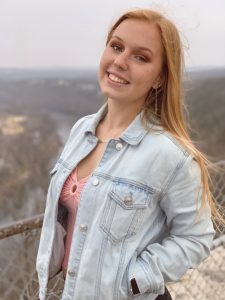
This semester, I had the privilege of joining the Oral History Center’s Save Mount Diablo Project as a background researcher under the mentorship of Shanna Farrell and Amanda Tewes. Despite growing up in the ‘Natural State’ of Arkansas, I didn’t learn much about environmental preservation. Coming into this research project, my personal definition of preservation was limited to the scope of society and culture. I’ve focused my studies on supporting and amplifying the perspective of marginalized communities, because they are often overshadowed by dominating narratives. Working on this project taught me about two important things that were missing from my definition of cultural preservation: land conservation and oral histories. Because I learned about the deeply rooted connections between environmental preservation and personal narratives, I now see clearly how important these facets are to the preservation of cultures and histories from all voices.
Save Mount Diablo (SMD) is a nationally accredited land trust organization and has been working to conserve the land around Mount Diablo in the East Bay since 1971. The preservation of natural land is a main goal of SMD, and has thus far been achieved through consistent advocacy, dedicated stewardship, thoughtful land-use planning, and educational programs. Mount Diablo’s biodiversity, historical and agricultural significance, and natural beauty are important to both the area’s general quality of life and natural resources. SMD works to provide ways for people to interact with the environment at Mount Diablo through recreational opportunities that consistently protect the region’s natural resources and open spaces, such as their Discover Diablo public hiking program, educational classes with local schools, and the annual Four Days Diablo backpacking trip through the mountain. Below are two maps of 2020 The Mount Diablo Regional Trail Map, which both feature the Diablo Trail that spans across the entire regional area. Of the 338,000 total acres shown between both maps, more than 120,000 acres have been preserved and protected thanks to Save Mount Diablo. Seth Adams, SMD’s Land Conservation Director, says that “No other map shows all of the Diablo area parks in a unified design and in regional context. The map illustrates what has been accomplished and what private lands still need to be protected.” (SMD website) The first map features Mount Diablo State Park and surrounding parks, and the second features Los Vaqueros and surrounding parks.
Mount Diablo & Surrounding Parks:
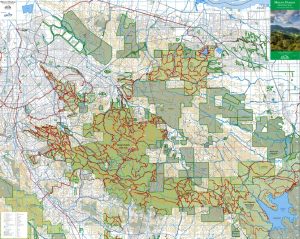
Los Vaqueros & Surrounding Parks:
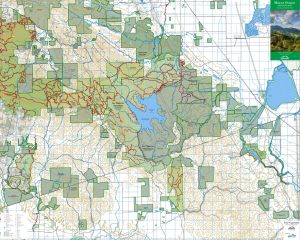
Image Credits: maps produced by Save Mount Diablo
In my research about Save Mount Diablo, it became apparent that working alongside surrounding community members -including SMD membershipSMD membership, various outside organizations, and political leaders/institutions- has been vital to maintaining their mission of preserving the environment. My first point of interest here was learning more about which communities and organizations SMD has worked with, how, and why. I immediately thought of Indigenous communities connected with Mount Diablo. Bev Ortiz, a Native American historian and SMD newsletter contributing author, wrote an article entitled “Mount Diablo as Myth and Reality: An Indian History Convoluted,“ in which she describes the mountain’s cultural and religious significance to Native Nations. Mount Diablo is meaningful for the Nations of the Miwok, Maidu (Nisenan), Ohlone (Chochenyo), Pomo, and Wintun Nations. Ortiz connected with members from these Native Nations in her work of preserving their cultural connections with Mount Diablo, from whom she learned about these connections, which included creation stories of several Nations. Creation stories are the original forms of oral history, and have helped preserve Indigenous cultures for thousands of years. Below is a map by Mount Diablo State Park of languages spoken by Native Americans from the region of Mount Diablo.
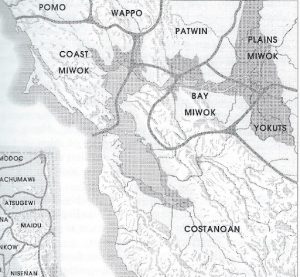
Image Credit: Mount Diablo State Park
Save Mount Diablo has often recognized Native cultural connections with Mount Diablo throughout its efforts to protect the mountain, such as in SMD Director of Land Programs Seth Adams’ timeline of the History of Mount Diablo, SMD’s stance to protect Tesla Park, and SMD Executive Director Ted Clement’s event to discuss SMD’s work with Indigenous communities to preserve cultural resources. Native American culture strongly connects with the environment, as they were the Earth’s first caretakers and the first to sustainably manage the world’s natural resources. Indigenous Nations around the world have maintained that stewardship of their ancestral homelands would be the first step to restoring their relationship with the land after colonization. In this sense, the inclusion of Native communities in environmental preservation would also aid in the preservation of their culture(s). To me, Save Mount Diablo’s work with Native communities thus far indicates their sincere recognition of how important the preservation of Native connections with Mount Diablo are to preserving the region’s land. Though there is definitely recognition, I remain curious as to the extent Indigenous communities are directly involved in SMD’s stewardship and conservation of Mount Diablo lands.
Another part of the community Save Mount Diablo works within is the political sphere. SMD has been heavily involved in, or at least taken stances on, several ballot measures throughout its50 years of fighting for environmental preservation. SMD also spends a lot of time tracking proposals by potential developers to ensure they follow the environmental rules and protections set by the California Environmental Quality Act (CEQA) of 1970. The main purpose of CEQA is to prevent and decrease environmental damage by developments and to allow a public decision-making process, which enables community members to discuss their concerns regarding development projects’s environmental effects. This work has led to SMD’s working with local political leaders and alliances with conservation networks in order to defend Urban Limit Lines (ULLs) against developers of preserved space in the Mount Diablo region. These ULLs preserve and protect open spaces, and are often threatened by developers, corporations, and some politicians. In their encouragement of public engagement with these issues, SMD provides email templates to send to local and state political leaders about issues at hand. Save Mount Diablo has been successful in these political methods of environmental preservation largely due to their active involvement and communication with outside persons, organizations, and institutions. Through its years of interactions with political representatives, public organizations, and parks districts, I wonder how, if at all, SMD’s standing as a private organization has affected the outcomes of these interactions. Additionally, I’m curious about how situational outside influences affected these interactions.
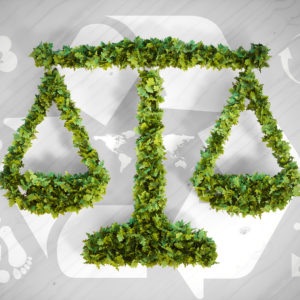
Image Credit: EnvironmentalScience.org
When learning about stories of the past, even those of organizations like Save Mount Diablo, it’s important to think about the perspective from which the story is being told. Learning about oral history played a big role in helping me realize that because of its practice to amplify and preserve individual voices so as to learn about their personal and lived experiences of historical occurrences. UC Berkeley’s Oral History Center (OHC) continues this mission across a variety of projects, including in this Save Mount Diablo Project. An ultimate goal of the SMD oral histories is to understand how the organization promotes a thoughtful relationship between people and the environment to inspire positive growth for the natural land and society as a whole. The background research I was able to contribute this semester barely scratched the surface of this story, and the rest lies in the stories soon to be told in the oral histories of Save Mount Diablo.
Learning about notable contributions of Save Mount Diablo to land conservation and environmental preservation taught me about how intersectional preservation is with most, if not all, facets of life. Not only do they work to conserve land that is sacred both biologically and culturally, SMD consistently provides recreational and educational resources for teaching and learning about the environment and the importance of preserving it. Now, it’s time for the preservation of Save Mount Diablo’s stories.
OHC’s Director’s Column: April 2021
Martin Meeker’s April 2021 Director’s Column
With the month of May fast approaching, I have been thinking a great deal about motherhood in general and my Mom in particular. Growing up, Mother’s Day was a big deal around my house — and my Mom wasn’t shy about letting us know that she appreciated the day off (from work at the office and home) and didn’t mind a little fuss being made for her. And she deserved it. My two sisters and I put her (and my Dad) through the paces. The entry of her kids into adulthood wasn’t so easy, either, with our cultural and political clashes, divorces, and career uncertainty. But our family persisted, largely due to my Mom, who willingly, or perhaps expectedly, assumed a peacemaker role. Lately, the COVID-19 pandemic has brought the family more closely together with regular Zoom reunions and an active, if usually silly, text group.
This week will mark the first time I get to lay my eyes on my mom in about 18 months — too long, considering that she’ll turn 80 this year. So, I’m thinking about the many, often difficult, roles that mothers are compelled to play and how those roles have changed. And, with COVID, have become more fraught and challenging.

When I begin to ponder something, arcane or universal, I’ll often turn to the OHC archive of 4000 oral histories with an eye to hearing first person accounts of real experiences on a given topic. Thankfully, our archive is replete with mainstream and remarkable stories of women who reflect on the joys, the work, the meaning, and the trials of motherhood.
Beverly Hancock Bouwsma, who was interviewed in 2001 for the UC Berkeley History Department project as a faculty wife, mused throughout her oral history of familial division of labor and the work of motherhood — in her case raising five children. When asked by OHC historian Ann Lage, “Did you enjoy motherhood?” Bouwsma replied, “Oh, I loved it. I did. I mean, sometimes it’s the worst thing in the world, but I always had a nice time with the children and cared desperately about them growing up. It seems like I didn’t, because when I hear now what they did, and I never knew about it, it seems like I must have been an awful mother. But I remember, at the time, I did what I thought you should do, and I really cared a lot.” This brief response articulates the love and frustrations and ambiguity many narrators in our collection reveal about motherhood — their recollections are rarely pat, especially when given the opportunity to reflect and speak at length.
Bay Area businesswoman Margaret Liu Collins, who was interviewed in 2011, recalls having two children with a husband who was abusive. Eventually the marriage ended and she raised the kids on her own, which kept her busy trying to build a business during the daytime, attending prayer meetings in the evening, and soccer games on the weekends. Then tragedy struck: her seven-year-old son was hit by a drunk driver. Collins recounted the moment, “It was 1979 sometime in October. I heard a siren going past my house because our house was on Belmont Canyon Road. The school was just across the street. We moved there from Cupertino because I had to travel a lot to Texas to do all my real estate, as well as go to Hong Kong and meet all my clients. I heard footsteps running onto the deck of our driveway, and somebody banged on the door. I had a really bad feeling that something was happening. The girl next door came and said, ‘Mrs. Liu, your son has been hit by a van and has been taken by the fire department to a hospital nearby’.” She continued, “When I went to Mills Hospital, he was in a coma. The doctor said he might never wake up. I was in pain. He was a brilliant child. It was my child. How could he pre-decease me? He had a whole future ahead. He had always lived with such enthusiasm, such curiosity. He loved people, and everybody loved him. He was generous. He was kind. He was giving. He could always solve problems. I still remember at that moment, I was feeling very sad.” Several months of treatment, uncertainty, and fear followed. Eventually, her son emerged from his coma and made a full recovery. She thanked God for his blessings but it was her devotion and love that brought her son back from the brink.
As well as recollections from women about their own experiences of motherhood, OHC’s collection contains thousands of memories of mothers by daughters and sons. Shirley Henderson, who was interviewed for our Rosie the Riveter / World War II Home Front project, remembered growing up in Berkeley in the 1930s admiring her mom for engaging in service activities outside the home: “My mother was the original community volunteer. She was a very capable and bubbly, outgoing woman. She did Girl Scouts; she was indefatigable at the church. I wonder what churches are going to be like when there are no more women to work as volunteers, which is about where the churches are now, almost. She ran a Sunday school class, a very large class of girls, because the girls were all so enthusiastic about the class that they brought their friends. My mother had them from the fourth grade through the twelfth grade, the same girls for that whole time. My mother had a very good third ear, and some of those girls had family troubles, and they were lucky to have my mother. I can remember being jealous of them because my mother gave them more attention than she gave to me. But I didn’t need it. That’s, of course, the other half, the flip side.”
These passages represent the slightest hint at the extensive archive of stories of mothers and motherhood in the OHC collection. While OHC has never embarked on an “oral history of motherhood,” by using our search tool, you can construct your own such archive by uncovering many more of these remarkable narratives of exceptional mothers. And we hope you do this Mother’s Day and beyond.
Find these interviews and all our oral histories from the search feature on our home page. You can search by name, key word, and several other criteria.
From the Archives: Staff Picks
This month, we’re bringing you a special edition of our From the Archives department. Below are interviews, all available in the OHC archives, recommended by each of us. Enjoy digging through the crates!
Martin Meeker’s pick:
Andre Tchelistcheff: Grapes, Wine, and Technology. Some lives in our collection of interviews are just profoundly interesting, and well worth digging into. This might be because of difficulties surmounted, achievements recognized, or simply the quality of the telling. Our 1979 oral history with Andre Tchelistcheff reveals one such life that ticks all of those boxes. From his birth in Russia in 1901, through his harrowing escape during the Revolution, to his years in France studying viticulture, and his decades quite literally remaking California’s wine industry, Tchelistcheff lived a remarkably influential life while remaining rooted in his passions throughout.

Roger Eardley-Pryor’s pick:
J. Michael McCloskey (Mike McCloskey), “Sierra Club Executive Director and Chairman, 1980s-1990s: A Perspective on Transitions in the Club and the Environmental Movement,” conducted in 1998 and published in 1999, is the second oral history with Mike McCloskey as part of the Sierra Club Oral History Project. Mike, a longtime leader in one of the largest environmental organizations in the United States, discusses the Club’s growing pains associated with an upsurge in membership amid Ronald Reagan’s anti-environmental actions in the early 1980s. Today, in lieu of modern assaults against environmental protections, Mike’s oral history sheds light on ways environmentalists managed those challenges and even expanded their purview to international issues.
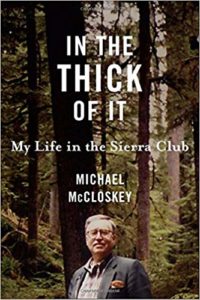
Amanda Tewes pick:
Paul Burnett’s pick:
I choose nurse educator and clinical nurse Angie Lewis, who worked at UC San Francisco during the early years of the AIDS crisis. In Lewis’ interview, we really hear what it was like to first learn of this then-unknown disease that was killing gay people in San Francisco in the early 1980s. But we also hear touching stories of the mobilization of community and medical support for those who were suffering from AIDS.
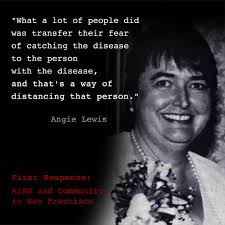
David Dunham’s pick:
David Blackwell: African American Faculty and Senior Staff Oral History Project. Named after an esteemed mathematician and the first African-American tenured professor at Cal, David Blackwell Hall opened this fall to honor Professor Blackwell. Read more about his pioneering life in his oral history, part of our African American and Senior Faculty Oral History Project.

Todd Holmes’ pick:
I’d recommend Francis Mary Albrier: Determined Advocate for Racial Equality. This oral history captures the extraordinary life of one of Berkeley’s most prominent citizens, from her leading role in fighting discriminatory hiring in the City’s schools and businesses to desegregating the famed Richmond Shipyards. Moreover, through her oral history, you get a clear view of the many unsung citizens that organized communities of color to collectively push for change.
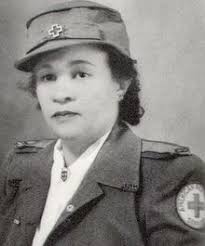
Shanna Farrell’s pick:
When I was first learning how to conduct longform interviews, I drew inspiration from Willa Baum, former director of the Oral History Center. She was an amazing interviewer, and her oral history interview provided insight into who she was, what drove her, and how she built the reputation of our office.
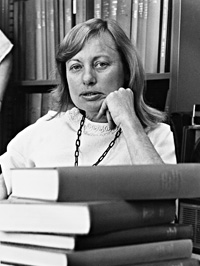
Theresa Hak Kyung Cha at Berkeley

January 31- April 22 ,the UC Berkeley Art Museum and Pacific Film Archive (BAMPFA) exhibit, “Theresa Hak Kyung Cha: Avant Dictée” celebrates the prolific, short-lived career of the influential Asian American artist and writer Theresa Hak Kyung Cha. Centered around Cha’s magnum opus, Dictée, the exhibit will include extra-textual art and writing from Cha’s body of work which corresponds thematically to the ten chapters of Dictée. Continue reading “Theresa Hak Kyung Cha at Berkeley”
Library Leaders Forum 2016
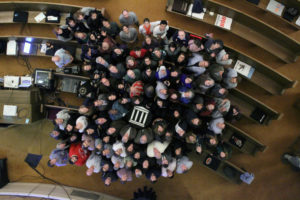
On October 26-28, I had the honor of attending the Library Leaders Forum 2016, which was held at the Internet Archive (IA). This year’s meeting was geared towards envisioning the library of 2020. October 26th was also IA’s 20th anniversary. I joined my Web Science and Digital Libraries (WS-DL) Research Group in celebrating IA’s 20 years of preservation by contributing a blog post with my own personal story, which highlights a side of the importance of Web preservation for the Egyptian Revolution. More personal stories about Web archiving exist on WS-DL blog.
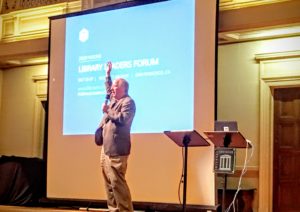
In the Great room at the Internet Archive Brewster Kahle, the Internet Archive’s Founder, kicked off the first day by welcoming the attendees. He began by highlighting the importance of openness, sharing, and collaboration for the next generation. During his speech he raised an important question, “How do we support datasets, the software that come with it, and open access materials?” According to Kahle, the advancement of digital libraries requires collaboration.
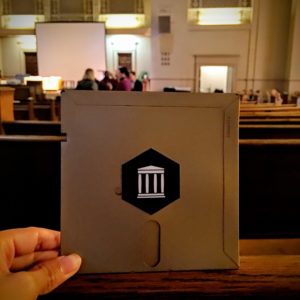
After Brewster Kahle’s brief introduction, Wendy Hanamura, the Internet Archive’s Director of Partnership, highlighted parts of the schedule and presented the rules of engagement and communication:
- The rule of 1 – Ask one question answer one question.
- The rule of n – If you are in a group of n people, speak 1/n of the time.
Before giving the microphone to the attendees for their introductions, Hanamura gave a piece of advice, “be honest and bold and take risks“. She then informed the audience that “The Golden Floppy” award shall be given to the attendees who would share bold or honest statements.
Next was our chance to get to know each other through self-introductions. We were supposed to talk about who we are, where we are from and finally, what we want from this meeting or from life itself. The challenge was to do this in four words.

After the introductions, Sylvain Belanger, the Director of Preservation of Library and Archives in Canada, talked about where his organization will be heading in 2020. He mentioned the physical side of the work they do in Canada to show the challenges they experience. They store, preserve, and circulate over 20 million books, 3 million maps, 90,000 films, and 500 sheets of music.
“We cannot do this alone!” Belanger exclaimed. He emphasized how important a partnership is to advance the library field. He mentioned that the Library and Archives in Canada is looking to enhance preservation and access as well as looking for partnerships. They would also like to introduce the idea of innovation into the mindset of their employees. According to Belanger, the Archives’ vision for the year 2020 includes consolidating their expertise as much as they can and also getting to know how do people do their work for digitization and Web archiving.
After the Belanger’s talk, we split up into groups of three to meet other people we didn’t know so that we could exchange knowledge about what we do and where we came from. Then the groups of two will join to form a group of six that will exchange their visions, challenges, and opportunities. Most of the attendees agreed on the need for growth and accessibility of digitized materials. Some of the challenges were funding, ego, power, culture, etc.
Our visions for 2020, challenges, opportunities – vision: growth & accessibility #libraryleaders2016 @internetarchive pic.twitter.com/ePkpKzvRGB
— Yasmina Anwar (@yasmina_anwar) October 27, 2016
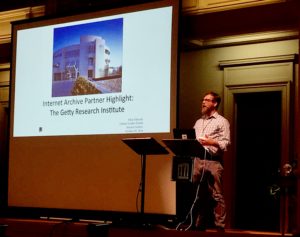
Chris Edward, the Head of Digital Services at the Getty Research Institute, talked about what they are doing, where they are going, and the impact of their partnership with the IA. Edward mentioned that the uploads by the IA are harvested by HathiTrust and the Defense Logistics Agency (DLA). This allows them to distribute their materials. Their vision for 2020 is to continue working with the IA and expanding the Getty research portal, and digitize everything they have and make it available for everyone, anywhere, all the time. They also intend on automating metadata generation (OCR, image recognition, object recognition, etc.), making archival collections accessible, and doing 3D digitization of architectural models. They will then join forces with the International Image Interoperability Framework (IIIF) community to develop the capability to represent these objects. He also added that they want to help the people who do not have the ability to do it on their own.
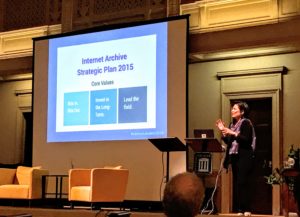
After lunch, Wendy Hanamura walked us quickly through the Archive’s strategic plan for 2015-2020 and IA’s tools and projects. Some of these plans are:
- Next generation Wayback Machine
- Test pilot with Mozilla so they suggest archived pages for the 404
- Wikimedia link rots
- Building libraries together
- The 20 million books
- Table top scribe
- Open library and discovery tool
- Digitization supercenter
- Collaborative circulation system
- Television Archive — Political ads
- Software and emulation
- Proprietary code
- Scientific data and Journals – Sharing data
- Music — 78’s
“No book should be digitized twice!”, this is how Wendy Hanamura ended her talk.
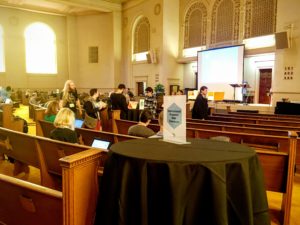 Then we had a chance to put our hands on the new tools by the IA and by their partners through having multiple makers’ space stations. There were plenty of interesting projects, but I focused on the International Research Data Commons– by Karissa McKelvey and Max Ogden from the Dat Project. Dat is a grant-funded project, which introduces open source tools to manage, share, publish, browse, and download research datasets. Dat supports peer-to-peer distribution system, (e.g., BitTorrent). Ogden mentioned that their goal is to generate a tool for data management that is as easy as Dropbox and also has a versioning control system like GIT.
Then we had a chance to put our hands on the new tools by the IA and by their partners through having multiple makers’ space stations. There were plenty of interesting projects, but I focused on the International Research Data Commons– by Karissa McKelvey and Max Ogden from the Dat Project. Dat is a grant-funded project, which introduces open source tools to manage, share, publish, browse, and download research datasets. Dat supports peer-to-peer distribution system, (e.g., BitTorrent). Ogden mentioned that their goal is to generate a tool for data management that is as easy as Dropbox and also has a versioning control system like GIT.
After a break Jeffrey Mackie-Mason, the University Librarian of UC Berkeley, interviewed Brewster Kahle about the future of libraries and online knowledge. The discussion focused on many interesting issues, such as copyrights, digitization, prioritization of archiving materials, cost of preservation, avoiding duplication, accessibility and scale, IA’s plans to improve the Wayback Machine and many other important issues related to digitization and preservation. At the end of the interview, Kahle announced his white paper, which wrote entitled “Transforming Our Libraries into Digital Libraries”, and solicited feedback and suggestions from the audience.
"Dark Archive is one of the WORST ideas ever" @brewster_kahle @internetarchive #libraryleaders2016
— Yasmina Anwar (@yasmina_anwar) October 27, 2016
@waybackmachine is the calling card of the @internetarchive and it has been neglected until recently #libraryleaders2016
— Merrilee Proffitt (@MerrileeIAm) October 27, 2016
"Dark Archive is one of the WORST ideas ever" @brewster_kahle @internetarchive #libraryleaders2016
— Yasmina Anwar (@yasmina_anwar) October 27, 2016
@waybackmachine is the calling card of the @internetarchive and it has been neglected until recently #libraryleaders2016
— Merrilee Proffitt (@MerrileeIAm) October 27, 2016
https://twitter.com/tripofmice/status/791790807736946688
https://twitter.com/tripofmice/status/791786514497671168
Its not what we can get away with, but rather what is the role of libraries in #copyright issues -Brewster K. #libraryleaders2016
— Dr.EB 🇵🇸 (@LNBel) October 27, 2016
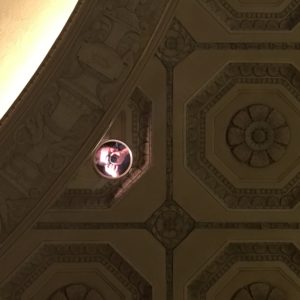
At the end of the day, we had an unusual and creative group photo by the great photographer Brad Shirakawa who climbed out on a narrow plank high above the crowd to take our picture.
On day two the first session I attended was a keynote address by Brewster Kahle about his vision for the Internet Archive’s Library of 2020, and what that might mean for all libraries.
"A library is engine for research!!" #libraryleaders2016 pic.twitter.com/D2du0L67T2
— Yasmina Anwar (@yasmina_anwar) October 28, 2016
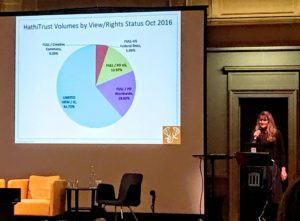
Heather Christenson, the Program Officer for HathiTrust, talked about where HeathiTrust is heading in 2020. Christenson started by briefly explaining what is HathiTrust and why HathiTrust is important for libraries. Christenson said that HathiTrust’s primary mission is preserving for print and digital collections, improving discovery and access through offering text search and bibliographic data APIs, and generating a comprehensive collection of the US federal documents. Christensen mentioned that they did a survey about their membership and found that people want them to focus on books, videos, and text materials.
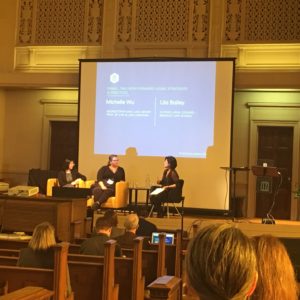
Our next session was a panel discussion about the Legal Strategies Practices for libraries by Michelle Wu, the Associate Dean for Library Services and Professor of Law at the Georgetown University Law Center, and Lila Bailey, the Internet Archive’s Outside Legal Counsel. Both speakers shared real-world examples and practices. They mentioned that the law has never been clearer and it has not been safer about digitizing, but the question is about access. They advised the libraries to know the practical steps before going to the institutional council. “Do your homework before you go. Show the usefulness of your work, and have a plan for why you will digitize, how you will distribute, and what you will do with the takedown request.”
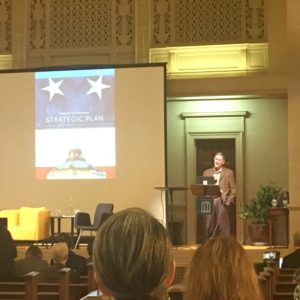
After the panel Tom Rieger, the Manager of Digitization Services Section at the Library of Congress (LOC), discussed the 2020 vision for the Library of Congress. Reiger spoke of the LOC’s 2020 strategic plan. He mentioned that their primary mission is to serve the members of Congress, the people in the USA, and the researchers all over the world by providing access to collections and information that can assist them in decision making. To achieve their mission the LOC plans to collect and preserve the born digital materials and provide access to these materials, as well as providing services to people for accessing these materials. They will also migrate all the formats to an easily manageable system and will actively engage in collaboration with many different institutions to empowering the library system, and adapt new methods for fulfilling their mission.
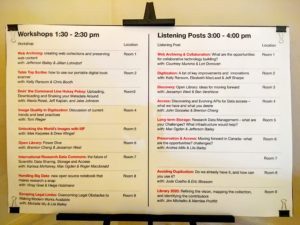
In the evening, there were different workshops about tools and APIs that IA and their partners provided. I was interested in the RDM workshop by Max Ogden and Roger Macdonald. I wanted to explore the ways we can support and integrate this project into the UC Berkeley system. I gained more information about how the DAT project worked through live demo by Ogden. We also learned about the partnership between the Dat Project and the Internet Archive to start storing scientific data and journals at scale.
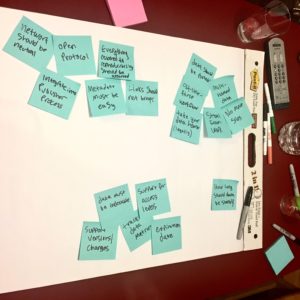
We then formed into small groups around different topics on our field to discuss what challenges we face and generate a roadmap for the future. I joined the “Long-Term Storage for Research Data Management” group to discuss what the challenges and visions of storing research data and what should libraries and archives do to make research data more useful. We started by introducing ourselves. We had Jefferson Bailey from the Internet Archive, Max Ogden, Karissa from the DAT project, Drew Winget from Stanford libraries, Polina Ilieva from the University of California San Francisco (UCSF), and myself, Yasmin AlNoamany.
Some of the issues and big-picture questions that were addressed during our meeting:
- The long-term storage for the data and what preservation means to researchers.
- What is the threshold for reproducibility?
- What do researchers think about preservation? Does it mean 5 years, 15 years, etc.?
- What is considered as a dataset? Harvard considers anything/any file that can be interpreted as a dataset.
- Do librarians have to understand the data to be able to preserve it?
- What is the difference between storage and preservation? Data can be stored, but long-term preservation needs metadata.
- Do we have to preserve everything? If we open it to the public to deposit their huge datasets, this may result in noise. For the huge datasets what should be preserved and what should not?
- Privacy and legal issues about the data.
Principles of solutions
- We need to teach researchers how to generate metadata and the metadata should be simple and standardized.
- Everything that is related to research reproducibility is important to be preserved.
- Assigning DOIs to datasets is important.
- Secondary research – taking two datasets and combine them to produce something new. In digital humanities, many researchers use old datasets.
- There is a need to fix the 404 links for datasets.
- There is should be an easy way to share data between different institutions.
- Archives should have rules for the metadata that describe the dataset the researchers share.
- The network should be neutral.
- Everyone should be able to host a data.
- Versioning is important.
Notes from the other Listening posts:
- LIBRARY 2020: Refining the vision, mapping the collection, and identifying the contributors
- WEB ARCHIVING: What are the opportunities for collaborative technology building?
- DIGITIZATION: Scanning services–develop a list of key improvements and innovations you desire
- DISCOVERY: Open Library– ideas for moving forward
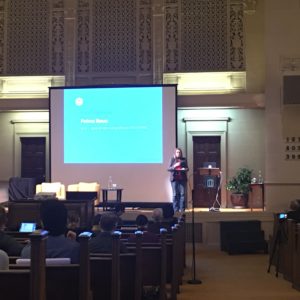
At the end of the day, Polina Ilieva, the Head of Archives and Special Collections at UCSF, wrapped up the meeting by giving her insight and advice. She mentioned that for accomplishing their 2020 goals and vision, there is a need to collaborate and work together. Ilieva said that the collections should be available and accessible for researchers and everyone, but there is a challenge of assessing who is using these collections and how to quantify the benefits of making these collections available. She announced that they would donate all their microfilms to the Internet Archive! “Let us all work together to build a digital library, serve users, and attract consumers. Library is not only the engine for search, but also an engine for change, let us move forward!” This is how Ilieva ended her speech.
It was an amazing experience to hear about the 2020 vision of the libraries and be among all of the esteemed library leaders I have met. I returned with inspiration and enthusiasm for being a part of this mission and also ideas for collaboration to advance the library mission and serve more people.
–Yasmin AlNoamany